Sometimes we all need a little inspiration – a little guidance on how to do something we’re trying to achieve.
And if you’re currently looking for inspiration on how to create an email course as an irresistible lead magnet to grow your audience, well, you’re in the right place.
Because here we’re tearing down four successful email courses with tips on what to steal for your own.
Page Contents
1. Email Mastery – Master Email Marketing email course
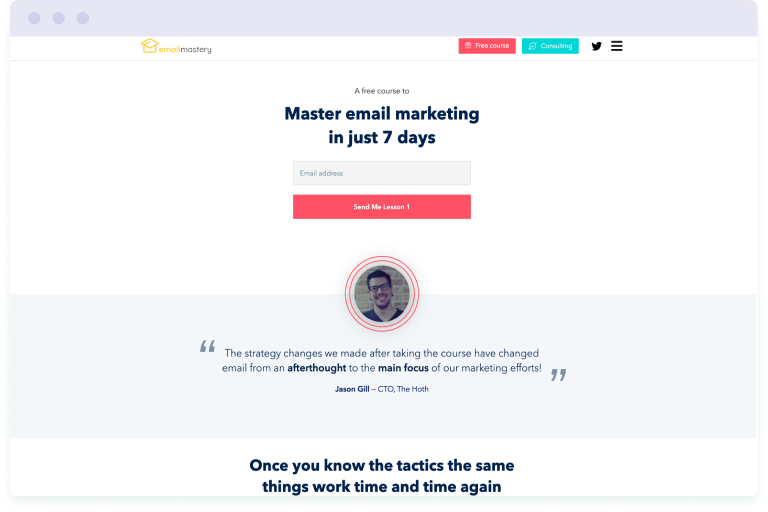
What could be better than an email course on how to do email marketing?
That’s what Alec Beglarian, the man behind Email Mastery, has created with his free 7-day email course to turn novices into email marketing masters.
Over the course of a week, subscribers get a daily lesson in email marketing – from growing a list to choosing the right metrics to measure and optimise. Let’s take a look at how this email course is structured.
Subject lines
To make sure that subscribers (or students – depending on how you look at them) spot the email course in their inbox, the subject line of each email includes the lesson number and the topic being covered.

There’s no confusion over who is sending these emails either. It’s clear that each email is coming from Email Mastery and the same sender name is used for every email in the course.
This consistency creates familiarity so that subscribers know what to look out for in their inbox.
Email lesson format
All of the seven emails in the course follow the same format with a clean, simple header displaying the Email Mastery logo, alongside the lesson name and number.

This helps build familiarity with the Email Mastery brand. The uncluttered header also means students can get straight down to business and start learning the day’s lesson – no unnecessary waffle that might diminish interest in the course.
Each lesson also ends in the same way – with a summary to remind students of what they’ve learned. Plus, there’s mention of what’s coming in the next lesson – this helps build anticipation and keeps open rates high.
But best of all, each email ends with a request to share the course with friends. Referrals are an excellent source of free traffic and this small request will mean more subscribers on the Email Mastery mailing list.
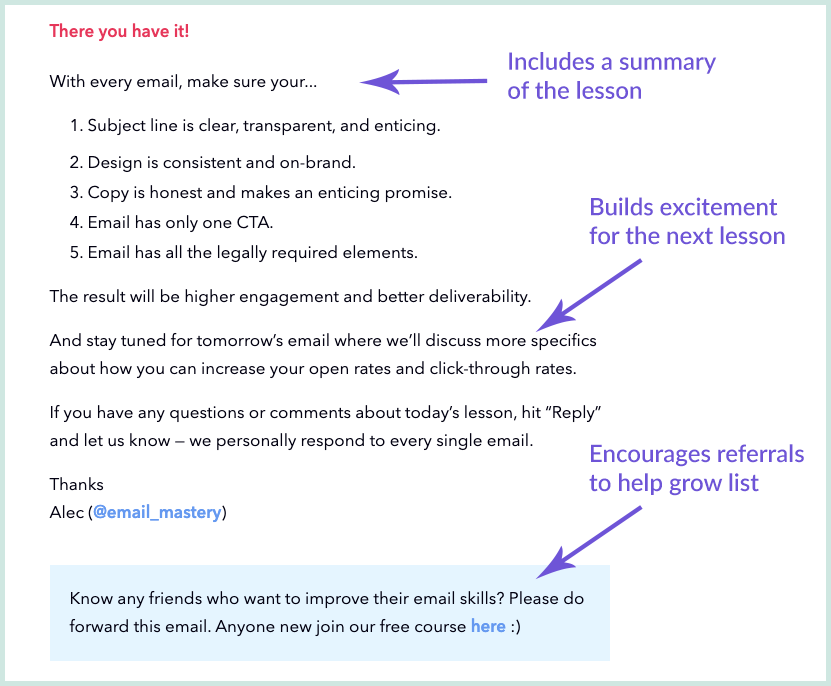
The bridging email
The bridging email is the email that bridges the gap between the end of the email course and the email communication that’s to follow. Hence the name.
It’s an important email as it moves your audience from the role of student to the role of receiver-of-marketing-emails. And it’s in future marketing communications where you gain more opportunities to secure a conversion, whatever that might be.
After the final lesson in the Email Mastery email course, students are followed up with a message of congratulations. This gives the recipient a feeling of accomplishment, and good vibes like this are just the sort of vibes you want your audience to associate with your brand.
More importantly, this message contains a round-up of valuable articles to help subscribers continue to grow as email marketers. And all of these articles sit on the Email Mastery website. This reminds the audience of the value Email Mastery brings and keeps them engaging with content.
It also primes the recipient for the weekly emails that will follow – the typical newsletters Email Mastery send to their audience outside of the email course.
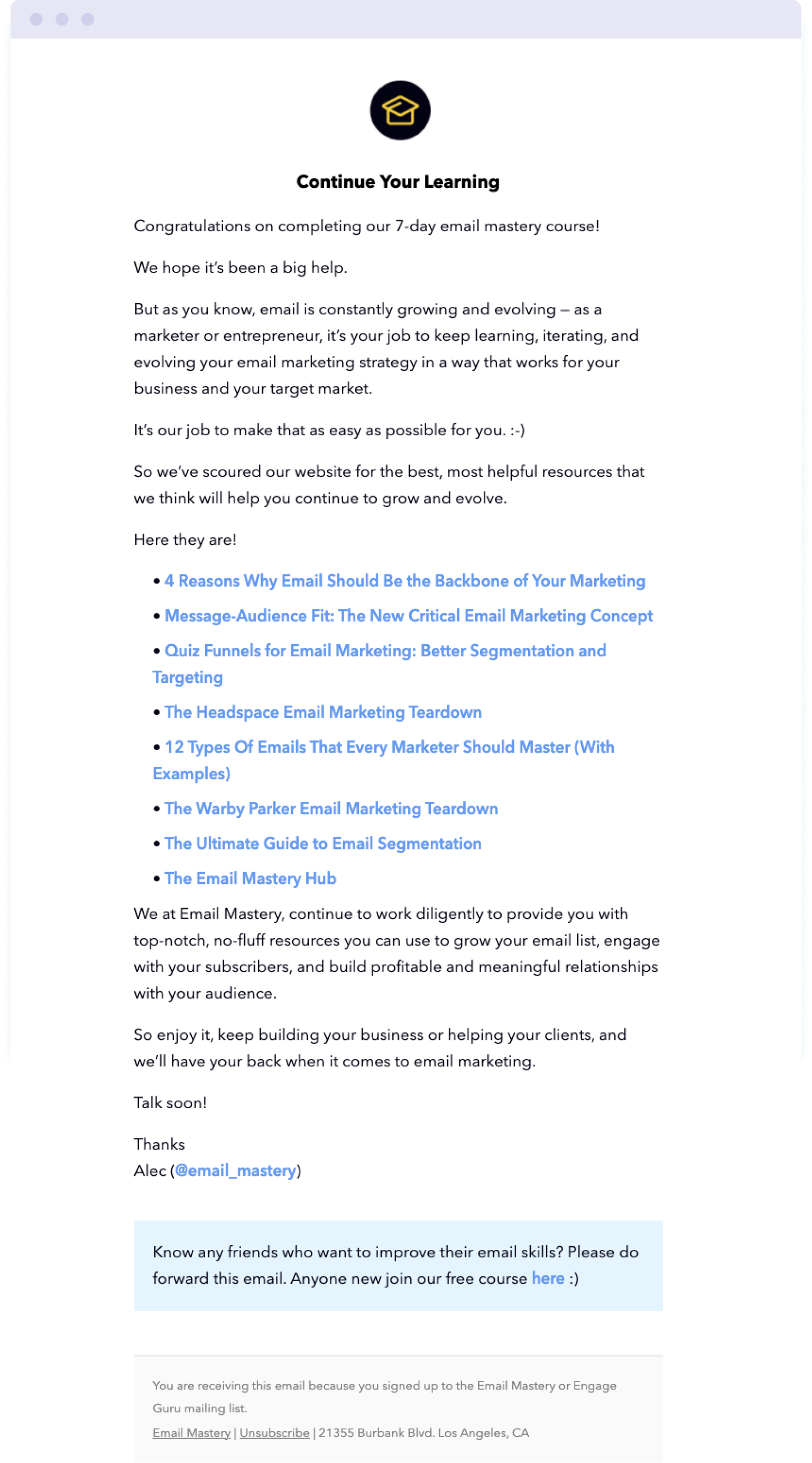
What to steal for your own email course
Now that we’ve seen how Email Mastery are doing it, here’s five takeaways to apply to your own email course:
- Choose a ‘from’ sender name that your subscribers will instantly recognise and keep that consistent across your entire email sequence.
- Use the subject line to name each email with the lesson number and subject so that students know what to expect.
- Sandwich your email course with a welcome message and a final congratulations.
- Ask for a referral and encourage students to share this email course with others to grow your audience further.
- Maintain consistent branding and layouts across every lesson in your course to build familiarity.
2. One Page Love – Landing Page Hot Tips email course
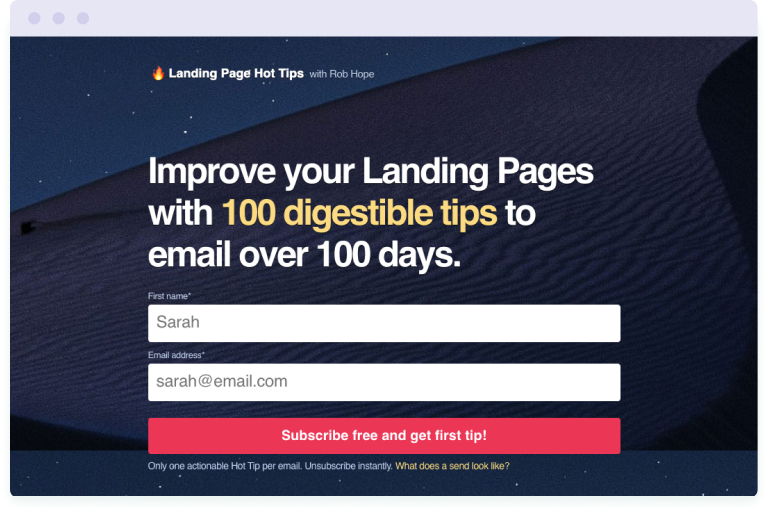
A good landing page is essential in converting website visitors, whether that’s into subscribers or customers. And to help you design a high-converting landing page, Rob Hope – EmailOctopus customer and the man behind One Page Love – delivers 100 actionable tips with his Landing Page Hot Tips email course.
Now, strictly speaking it’s not a course broken down into lessons. Instead, it’s a sequence of 100 tips taken from Rob’s eBook. But it’s still a great example of how to structure an email course in a less traditional fashion.
Let’s take a closer look.
Subject lines
Similarly to Email Mastery, each email in the Landing Page Hot Tips course has a subject line that references where a subscriber is in the sequence – hot tip #1, #2, etc – and a summary of what the day’s tip is.
But one thing that immediately grabs your attention is the use of emojis. In this case, the fire emoji to match the idea of ‘hot tips’.

By consistently using this emoji in lesson subject lines, subscribers become familiar with the Landing Page Hot Tips branding and will instantly recognise a new email from Rob in their inbox. And brand familiarity is key to becoming a powerful brand.
Speaking of familiarity, notice how the sender name includes the brand name – One Page Love – as well as Rob’s first name. This makes each email feel more personal, as Rob’s using his first name. It makes the subscriber feel as though they’re engaging with a real person’s content, not just some intangible brand.

Email lesson format
Rather than an in-depth lesson, each email in Rob’s Landing Page Hot Tips course is a bitesize tip. These emails are designed to be actionable nuggets of wisdom that readers can implement for immediate results.
And that’s why the word count for each email averages just 86 words. The copy has been honed so that each tip delivers value without any unnecessary words or distractions.
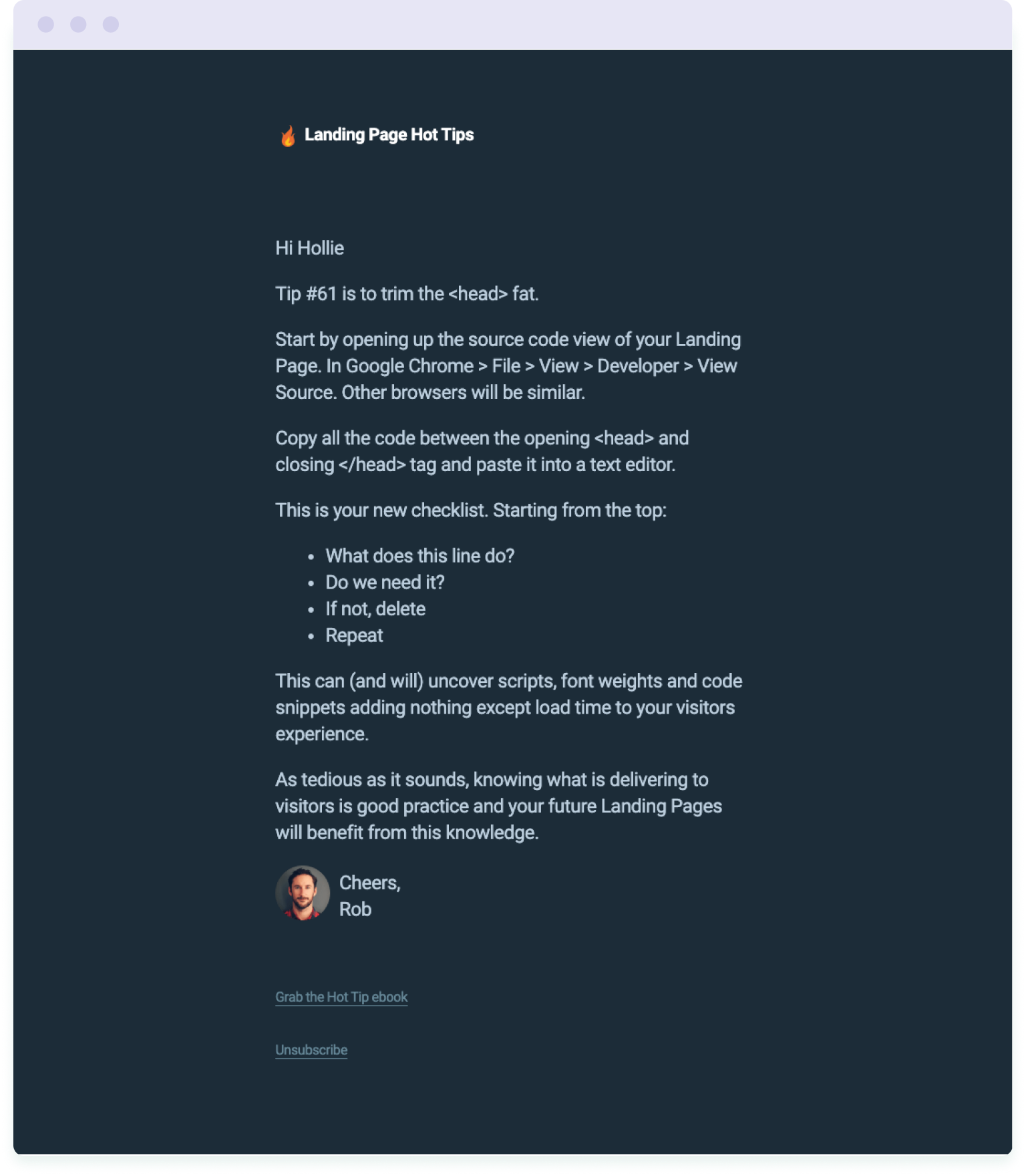
The design and layout of each email remains consistent across all 100 emails with a header that contains the course name and that fire emoji again. Each email also starts with a greeting addressing the subscriber by name. And then the email content is introduced with a one-line summary and the tip number so readers know where they are in the sequence.
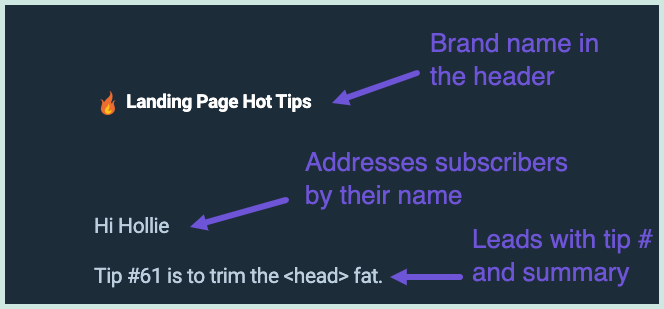
The footer of the emails also remains the same across the series with a sign-off accompanied by a picture of Rob, which helps build that feeling of familiarity. And more importantly, the footer includes a link to where readers can purchase a copy of the Hot Tip eBook. That, after all, is the end goal of this email course – to increase sales.
By including a subtle link at the end of the email, Rob provides his audience with the option to buy without being in the least bit pushy. It comes after value has been delivered in the form of the day’s hot tip. And the link doesn’t interfere with the valuable content.
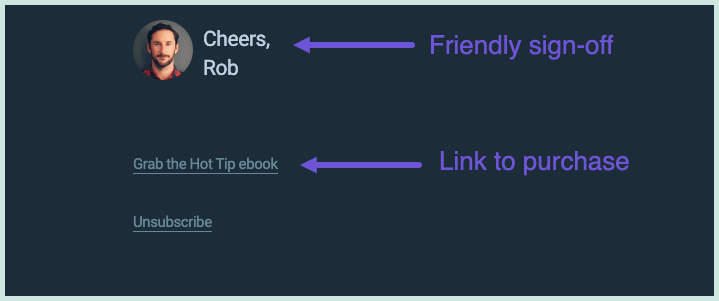
The conclusion email
The final email in an email course is an important one. It’s where you either move subscribers onto your main list and start sending them regular marketing communications. Or it’s where you deliver your sales pitch and encourage whatever conversion it is you’re seeking.
In the Landing Page Hot Tips email course, the final email is a behind-the-scenes look at all the work that went into creating the content and why Rob created this content in the first place.
And that aligns beautifully with Rob Hope’s personal brand as a maker and someone who shares his journey as a maker with his growing audience. So this behind-the-scenes email helps build a more personal connection with readers and invites them to become that little bit more invested in the content and the man himself. Which can only be a good thing.

This final email also includes three mentions of the eBook version of the course to secure that all-important conversion. But it’s bundled up in a polite request to “support the work I do” and the offer to save 70% with an exclusive discount code. In other words, it’s not a hard sell and quietly yet persuasively encourages readers to make a purchase.
What to steal for your own email course
Now that we’ve seen how One Page Love is doing it, here’s five takeaways to apply to your own email course:
- Pick one emoji that matches your course content and use this in your subject lines to make them stand out and to make your brand more memorable and distinctive.
- Consider putting your name against your email course and use this as your sender name so that subscribers feel more of a personal connection with your emails. You could also include a profile pic of you inside the emails.
- If you’re planning a longer course with many email lessons, don’t be afraid to keep the copy on the shorter side and make each lesson bitesized rather than in-depth.
- Include an unobtrusive link to the product or service you’re hoping to sell with your email course – the footer is usually the best place as it won’t interfere with the main lesson.
- If you’re developing an email course under your own personal brand, invite your audience behind the scenes so that they get to know you better. Talk to your readers as though they were friends on your creator journey and bring them along for the ride. It’ll help build a deeper connection.
3. Patch Plants – Houseplant Parenting email course
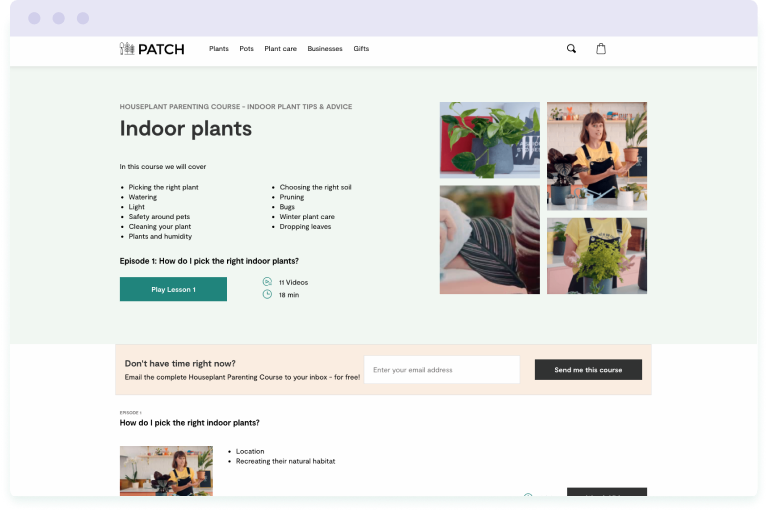
The unintended killing of a houseplant – we’ve all been there.
And if we’re honest with ourselves, it was absolutely our own fault. Either we watered it too much or didn’t water it enough.
If only there was a way we could all become better houseplant parents…
Enter Patch Plants and their free 11-day email Houseplant Parenting course. It’s the perfect lead magnet for a company that sells plants to those in need of more greenery in their home. And for those guilty of killing the green organisms in the past.
Let’s take a look at the Patch Plants email course in more detail.
Subject lines
Like Rob Hope, Patch Plants use emojis in their email lesson subject lines. Each subject line ends with one or two emojis that illustrate what the lesson is about. This helps make the emails more visible in the inbox.

And rather than a plain headline for the subject line, each lesson is introduced with a question – for example, “how much light does my plant need?”
This is clever way of identifying the reader’s pain points and the specific questions they have when it comes to looking after a houseplant. And by posing the question in the subject line, it’s implied that the email will answer this question. This tells the reader exactly what they will learn before they’ve even opened the email and it’s a good way to ensure high open rates.
Email lesson format
As we’ve come to expect, every lesson in the Patch Plants email course follows the same format for consistency, which helps breed familiarity. But as an ecommerce brand, Patch Plants has taken every opportunity to tie each lesson back to products available on their website. And that starts with the simple navigation links in the header inviting readers to browse their selection of plants and pots.
It continues with links back to the Patch Plants website throughout the lesson content, but only where it makes sense to do so and not in a distracting way. And it ends with a selection of related products and one final CTA button to take readers to the website to browse even more products.
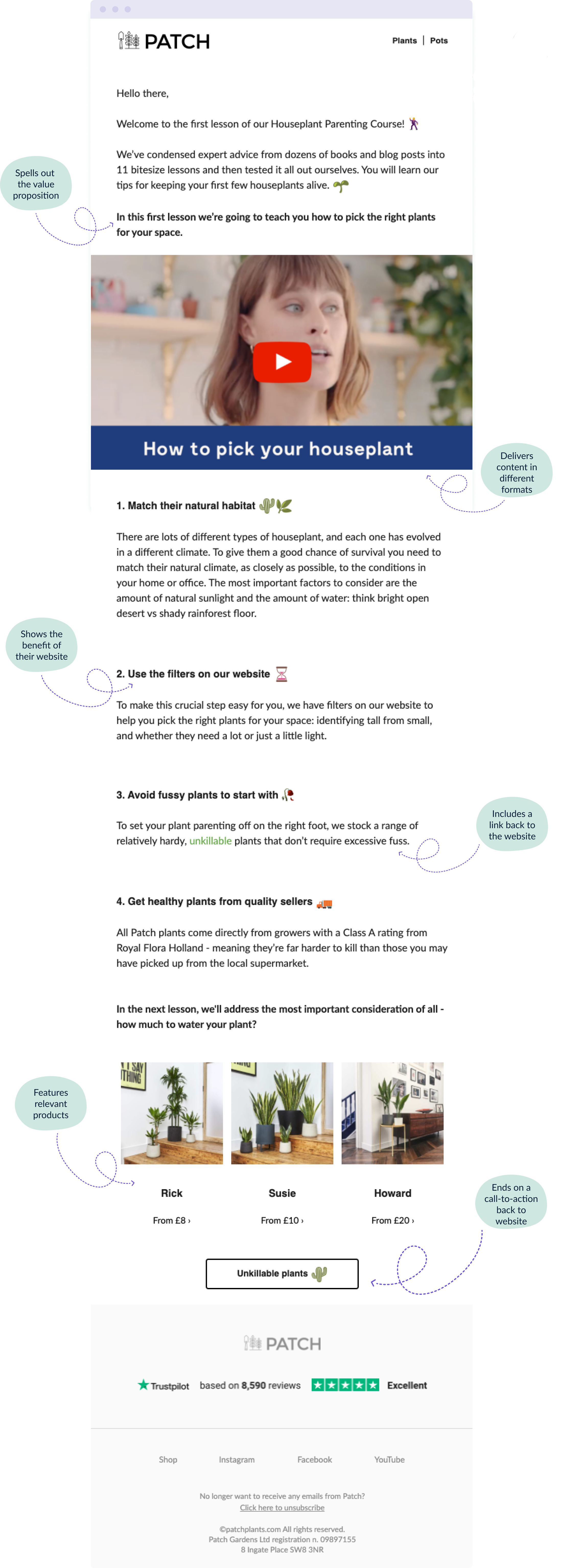
However, the focus is primarily on delivering value to readers and that’s why each lesson in the email course includes plenty of expert tips. And to make the content even more consumable, each lesson in the Patch Plants email course includes a link to a video.
The video sits on a page of the Patch Plants website, as well as their official YouTube channel where lesson #1 in the course has been viewed over 240,000 times.
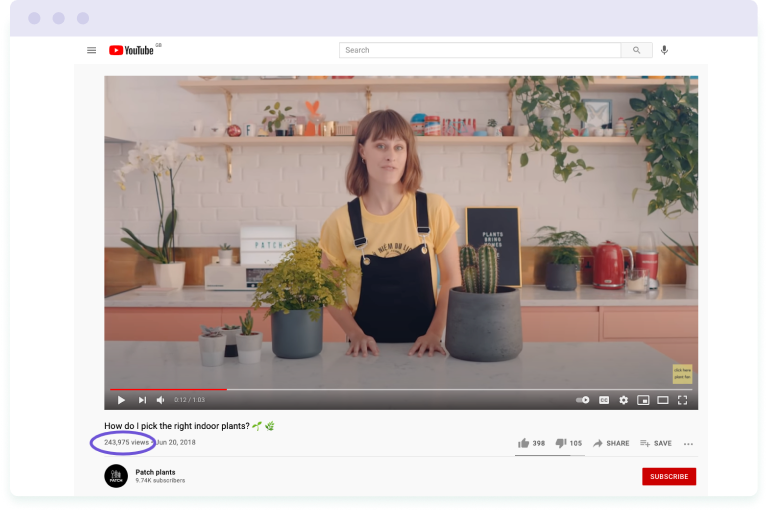
As well as providing their audience with a choice of how they consume the content – text or video – this also means that Patch Plants can extend their reach across multiple channels and grow their audience even further. The course is not confined to email – it attracts subscribers on YouTube too. This is a great example of repurposing content.
The bridging email
Many email courses will end with an email designed to get subscribers buying, or completing whatever action it is the business considers a conversion.
But Patch Plants does it differently. At the end of the email course, they surprise subscribers with bonus access to a second email course covering more advanced topics.
There’s no hard sell and no other call-to-action beyond joining Level 2 of the Houseplant Parenting course. The goal is simply to keep subscribers engaged and consuming content.
And this works nicely as every lesson already attempts to sell products by including links to products related to the topic of the lesson. That’s why it makes sense to conclude the course with an extra dose of free value – it will make subscribers feel more positively about the brand and encourage long-term engagement.
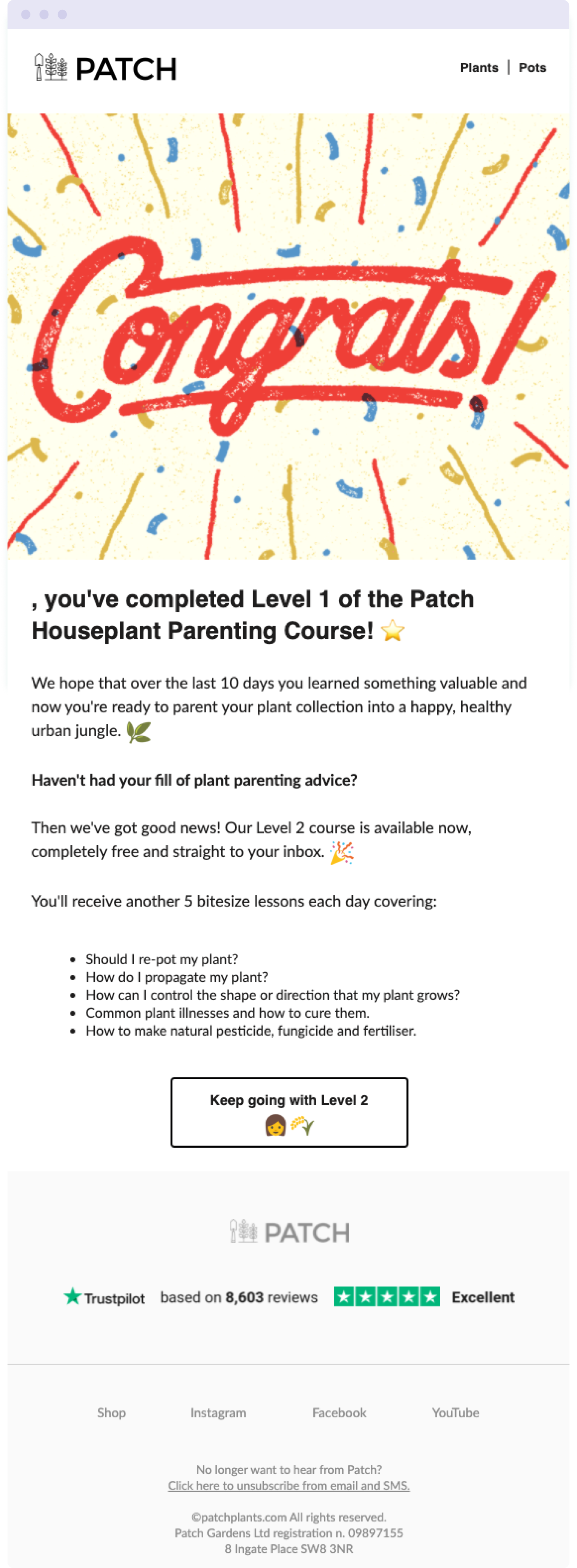
What to steal for your own email course
Now that we’ve seen how Patch Plants are doing it, here’s five takeaways to apply to your own email course.
- Use emojis to make your subject lines stand out in a crowded inbox and add personality to your email course.
- Try posing questions in your email lesson subject lines to address common pain points and indicate to your audience exactly what they will have the answer to after completing the lesson.
- If you’re an ecommerce brand, include links to products that tie in with each lesson in your email course sequence.
- Repurpose your content and turn your email course into videos for YouTube to extend your reach and grow your audience across multiple channels.
- Surprise subscribers with bonus content after they’ve completed your email course – this will really warm them to your brand and make them even more receptive to your sales pitch.
4. Natasha’s Kitchen – 5 Secrets to be a Better Cook email course
If you’re a blogger writing about the one topic, chances are pretty high that you could share some of your knowledge in an email course.
And that’s what food blogger Natasha Kravchuk does with her free email series. Over the course of five days, she shares her top five secrets to being a better cook. It’s an ideal way to attract website visitors onto her mailing list. After all, if you’re visiting Natasha’s Kitchen for recipes, you’ll likely be interested in cooking secrets that will improve your dishes.
Let’s take a look at the 5 Secrets to be a Better Cook email course in more detail.
Subject lines
One way to improve the open rates of your emails is to arouse curiosity. If people are intrigued by a subject line and want to know more, their curiosity will get the better of them and they’ll open the email.
That’s the psychology hack Natasha’s Kitchen uses in their email course subject lines. Rather than spelling out exactly what the lesson covers, the subject line instead acts like a teaser, merely hinting at what’s inside.

For example, secret #3 is “more important than you think”. But what is this secret? And why is it so important?
Well, you’ll only find out if you open the email. And that’s the point – to get people curious enough to open the email. But to build trust when using this tactic, the content of your email must deliver the goods. Which is what each email lesson does.
Email lesson format
Each lesson in the 5-day “how to be a better cook” email series jumps straight into the day’s secret. It begins with the reason why this secret is useful and then goes into detail of what the secret is and how to use it in your own cooking.
The lessons are designed to be actionable – readers should be able to read the email and then put the secret into practice. This is what makes the course valuable.
When relevant, there are also links to more content related to the topic. In email lesson below, there’s a link to a YouTube video teaching basic knife skills. As we saw with the Patch Plants email course example, this is a great way of extending your reach across channels and encouraging your mailing list subscribers to become YouTube subscribers.
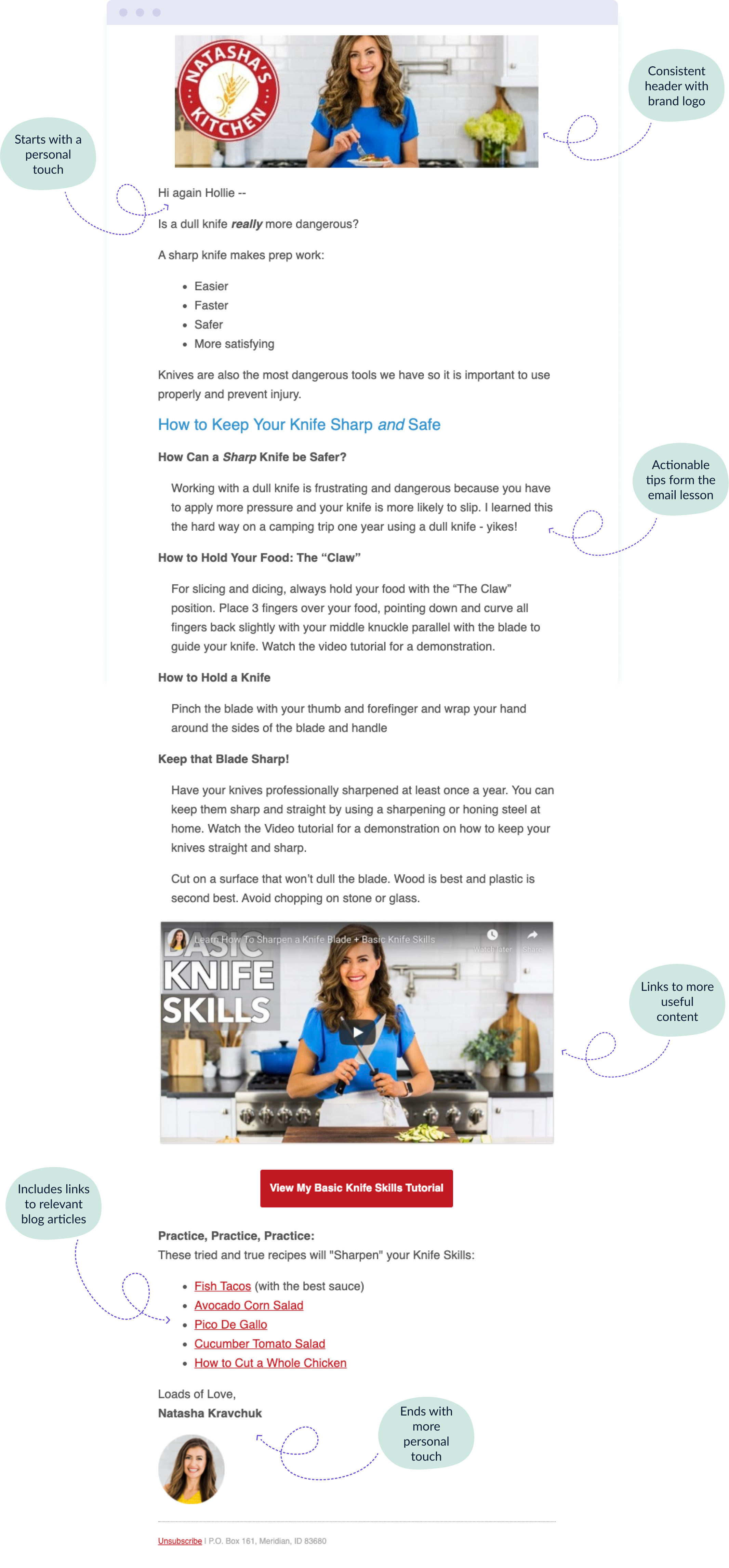
Some of the emails in the course also end with a selection of recipes that provide an opportunity for readers to apply what they’ve learned. This provides additional value to the reader in the form of extra content that they might find useful. And it also drives traffic back to the Natasha’s Kitchen website, which keeps readers further engaged with the brand.
The conclusion email
Rather than a separate wrap up email, the Natasha’s Kitchen email course ends with the fifth secret (and the final lesson). But in this final email, Natasha signs off with a message that gives subscribers an idea of what to expect next – more cooking tips and recipes.
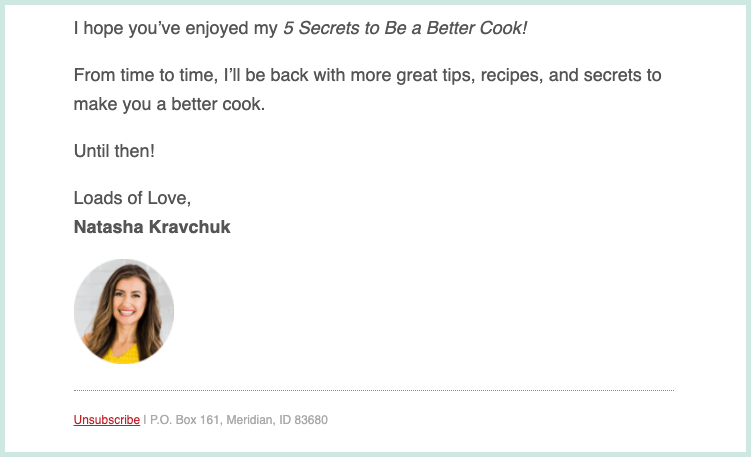
This works nicely when the main purpose of your email course is to optimise your lead strategy – in other words, get people on your mailing list. Subscribers know they’ll continue to hear from you and expect that they’ll receive the same quality content delivered in the email course. That’s to say that if a subscriber has completed the course, they’re likely to stay subscribed and continue receiving emails.
What to steal for your own email course
Now that we’ve seen how Natasha’s Kitchen is doing it, here’s five takeaways to apply to your own email course.
- Arouse curiosity in your subject lines to keep open rates high – hint at what the day’s lesson covers without making it explicitly clear.
- Explain not only the how, but also the why, so that readers understand the benefit of the day’s lesson.
- Create video tutorials that match the topic of each lesson so that you can grow your audience across multiple channels, including email and YouTube.
- Include links back to related content to drive more traffic to your website.
- Instead of creating a separate wrap up email to conclude the email course, use the last lesson to explain what happens next – how often you’ll be emailing subscribers and the type of content they can look forward to.
Wrapping up
And there you have it – four examples of email courses, dozens of ideas to steal for your own.
As these examples show, there are many different ways to format your email course and write subject lines that get people opening your emails. Now it’s over to you to take these ideas and create an irresistible lead magnet that will grow your audience and nurture those all-important leads.


No Comments
Leave a comment Cancel